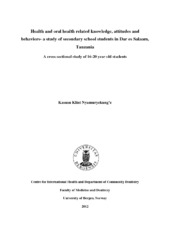Health and Oral Health related knowledge, attitudes and behaviors - a study of secondary school students in Dar es Salaam, Tanzania. A cross sectional study of 16-20 year old students
Master thesis
Permanent lenke
https://hdl.handle.net/1956/6187Utgivelsesdato
2012-05-18Metadata
Vis full innførselSamlinger
Sammendrag
Aim: To assess the socio-demographic distribution, relationship and levels of health and oral health related knowledge, attitudes and behaviors among secondary school students in Dar-es-Salaam region, Tanzania. Methods: A cross-sectional survey by means of a self-administered questionnaire to 1934 secondary school students aged 16-20 (mean age 16.9 years). A one stage, proportionate, cluster sampling technique was used, and covered 18 schools from three districts. Results: Regular tooth brushing was widely practiced by 78.9% of the students. The hygiene behavior levels were low. Hand washing with soap was the least performed hygiene behavior (21.6%) and its performance was greatly influenced by wealth index, gender and parental education. Levels of physical activities were low overall; females had a higher level of physical inactivity as compared to males. Belonging in the wealthiest quartile was associated with higher frequencies of consumption of sugary foodstuffs and fast foods, although having a parent with a high level of education was associated with an increased consumption of fruits and vegetables. Levels of alcohol use were moderately high (25.5%) whereas those of cigarette consumption were low (6.7%). Usage of both substances was more prevalent in male students. Levels of dental attendance were low (19.0%) and were associated with belonging in the wealthiest quartile and having a parent with a high level of education. Conclusion: A socio-economic and gender vector was apparent and varied greatly in many of the assessed behaviors. Overall levels of students' health and oral health related knowledge and attitudes were good.
Utgiver
The University of BergenOpphavsrett
Copyright the author. All rights reservedBeslektede innførsler
Viser innførsler beslektet ved tittel, forfatter og emneord.
-
Attributes and consequences of health information systems data for antenatal care : Health status, health system performance and policy
Venkateswaran, Mahima (Doctoral thesis, 2019-11-05)Background: A routine health information system (RHIS) serves as an important source of data for monitoring health of clients and health system performance. All countries use RHIS data for some form of priority setting; ... -
A Critical Perspective on Mental Health News in Six European Countries: How Are “Mental Health/Illness” and “Mental Health Literacy” Rhetorically Constructed?
Van Beveren, Laura; Rutten, Kris; Hensing, Gunnel; Spyridoula, Ntani; Schønning, Viktor; Axelsson, Malin; Bockting, Claudi; Buysse, Ann; de Neve, Ine; Desmet, Mattias; Dewaele, Alexis; Giovazolias, Theodoros; Hannon, Dewi; Kafetsios, Konstantinos; Meganck, Reitske; Øverland, Simon Nygaard; Triliva, Sofia; Vandamme, Joke (Journal article; Peer reviewed, 2020)In this study, we aim to contribute to the field of critical health communication research by examining how notions of mental health and illness are discursively constructed in newspapers and magazines in six European ... -
Health managers’ views on the status of national and decentralized health systems for child and adolescent mental health in Uganda: a qualitative study
Akol, Angela; Engebretsen, Ingunn Marie S.; Skylstad, Vilde; Nalugya, Joyce; Ndeezi, Grace; Tumwine, James K. (Peer reviewed; Journal article, 2015-12-08)Background: Robust health systems are required for the promotion of child and adolescent mental health (CAMH). In low and middle income countries such as Uganda neuropsychiatric illness in childhood and adolescence represent ...
